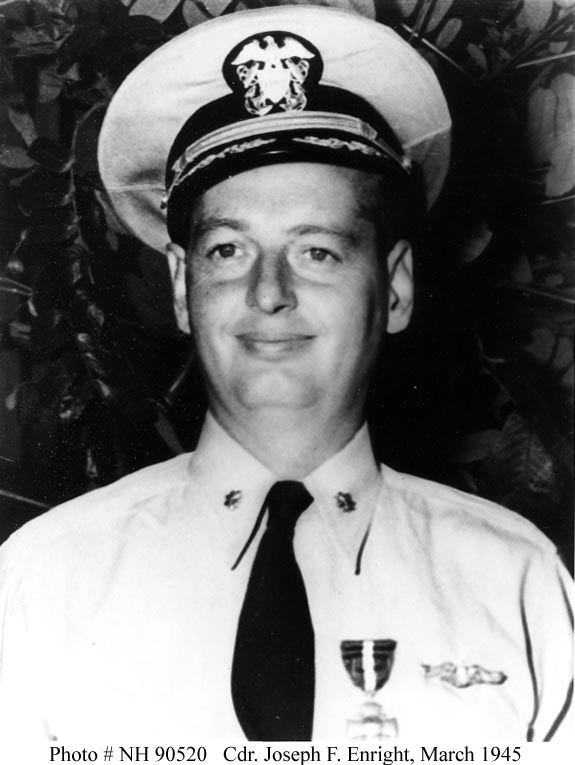Rank Captain | Name Joseph Enright | |
 | ||
Born September 18, 1910Minot, North Dakota ( 1910-09-18 ) Allegiance United States of America Commands held USS O-10 (SS-71)USS Dace (SS-247)USS Archerfish (SS-311) Awards Navy CrossLegion of Merit with "V" Device Place of burial Arlington National Cemetery, Arlington, Virginia, United States | ||
Joseph Francis Enright (September 18, 1910, Minot, North Dakota – July 20, 2000, Fairfax, Virginia) was a submarine captain in the United States Navy. He is best known as the man who sank the Japanese aircraft carrier Shinano–the "most significant single submarine sinking of World War II."
Contents
US Navy career
Enright graduated from United States Naval Academy in 1933, served three years on USS Maryland and achieved submariner's qualification in 1936. During World War II lieutenant commander Enright commanded USS O-10, USS Dace and USS Archerfish.
Enright assumed command of the newly built USS Dace on July 23, 1943 and in October sailed out on her first war patrol into busy Japanese waters. On November 15 an Ultra message alerted him to intercept aircraft carrier Shōkaku; Enright located the target and "made a timid approach, abandoning the effort as daylight approached". He then found another target, a tanker, but was depth charged by escort ships and withdrew from active pursuit. In the end the 49-day patrol brought no results. Enright took the blame for failure: "I was responsible for an unproductive patrol and request to be relieved by an officer who can perform more satisfactorily". Admiral Lockwood granted the request and demoted Enright to administrative duties ashore. After half a year at Midway submarine base, Enright requested to be given another submarine command and received "a rare second chance", command of USS Archerfish, in September 1944.
Archerfish left Pearl Harbor on October 30, 1944 and reached Saipan on November 9. For the next two weeks the submarine provided search and rescue support to American aviators in the areas of planned air strikes. On November 28, when the submarine was patrolling south from Nagoya, radar identified a surface contact 12 miles away. Visual contact became possible at 2140, and by 2300 Enright identified it as an aircraft carrier protected by four destroyers. At 0241 November 29 the target turned away from Archerfish and then straight at her. At 0317 at a mere 1,400 yards from the target, Enright fired all six available torpedoes at the carrier. Enright stayed at periscope depth to see first two torpedoes hit Shinano, then dived down to escape revenge from her escorts. It was only after the war that the carrier was identified as Shinano, the long-rumored third battleship of the Yamato class. Her keel had been converted into a supercarrier while still under construction. Four of his sub's torpedoes had found their mark. Due to crew inexperience and design flaws, she struggled with damage for more than seven hours and finally capsized at 10:57. With a full-load displacement of 72,000 tons, Shinano is the largest warship in history to be sunk by a submarine. The action earned Enright his Navy Cross.
On September 2, 1945, Enright and his crew, along with eleven other submarines, were honored with the task of protecting USS Missouri during the signing of Japanese Instrument of Surrender.
After the end of World War II Enright commanded Submarine Division 31 (1949–1950), USS Fulton (1953–1954), Submarine Squadron 8 (1954–1955), was chief of staff for the submarine force of the United States Atlantic Fleet (1955–1957) and commander of USS Boston (1959–1963).
Retirement years
After retirement in 1963 Enright worked at Northrop on the OMEGA Navigation System.
He is buried at Arlington National Cemetery.
